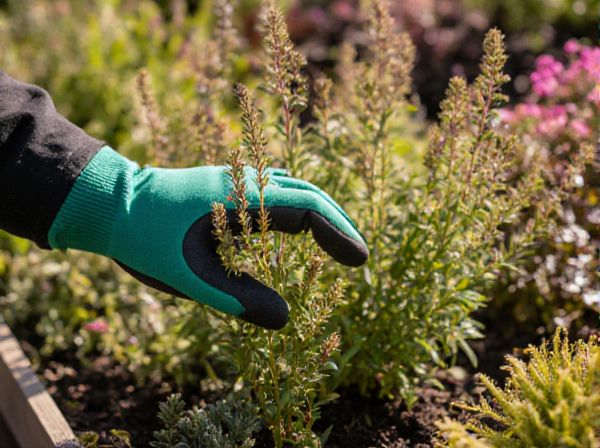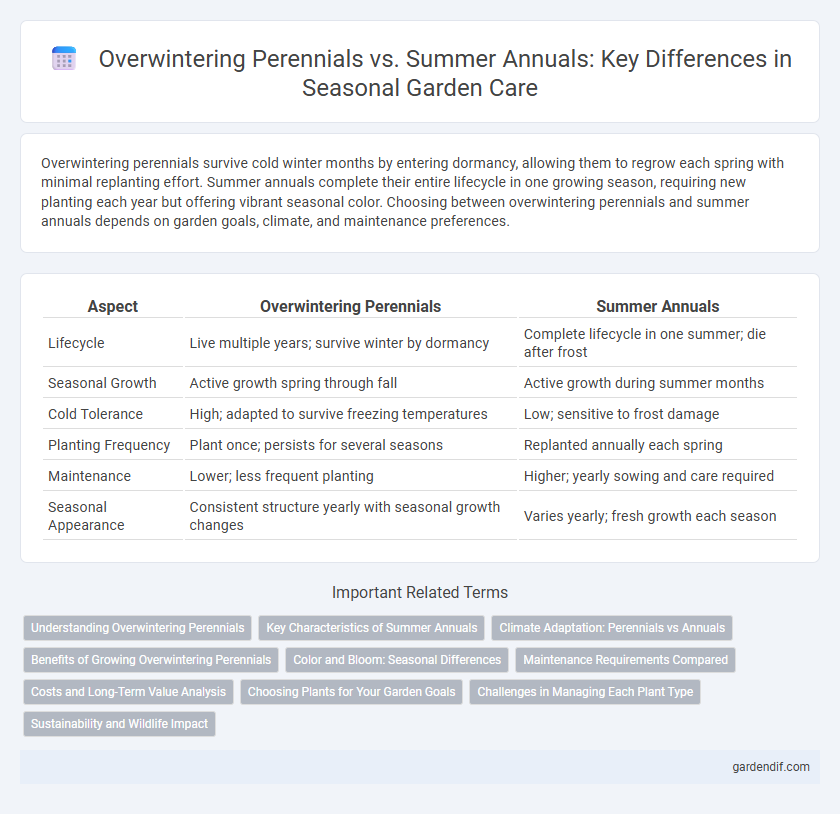
Overwintering perennials vs Summer annuals Illustration
Overwintering perennials survive cold winter months by entering dormancy, allowing them to regrow each spring with minimal replanting effort. Summer annuals complete their entire lifecycle in one growing season, requiring new planting each year but offering vibrant seasonal color. Choosing between overwintering perennials and summer annuals depends on garden goals, climate, and maintenance preferences.
Table of Comparison
| Aspect | Overwintering Perennials | Summer Annuals |
|---|---|---|
| Lifecycle | Live multiple years; survive winter by dormancy | Complete lifecycle in one summer; die after frost |
| Seasonal Growth | Active growth spring through fall | Active growth during summer months |
| Cold Tolerance | High; adapted to survive freezing temperatures | Low; sensitive to frost damage |
| Planting Frequency | Plant once; persists for several seasons | Replanted annually each spring |
| Maintenance | Lower; less frequent planting | Higher; yearly sowing and care required |
| Seasonal Appearance | Consistent structure yearly with seasonal growth changes | Varies yearly; fresh growth each season |
Understanding Overwintering Perennials
Overwintering perennials are plants that survive through cold winter months by entering a state of dormancy, allowing their root systems to remain viable until favorable growing conditions return. These plants contrast with summer annuals, which complete their entire life cycle--from germination to seed production--within a single growing season and die before winter. Understanding the biology and care of overwintering perennials, including mulching and site selection, is essential for ensuring their survival and vigorous growth year after year.
Key Characteristics of Summer Annuals
Summer annuals complete their life cycle within a single growing season, typically germinating in spring, flowering in summer, and dying by autumn. These plants often exhibit rapid growth, vibrant blooms, and high seed production to ensure reproduction before seasonal decline. Their adaptation to warm temperatures and drought tolerance allows them to thrive in intense summer conditions, differentiating them from overwintering perennials.
Climate Adaptation: Perennials vs Annuals
Perennials thrive in climates with cold winters, surviving by going dormant and regrowing each season, making them ideal for regions with harsh overwintering conditions. Summer annuals complete their life cycle within a single growing season, requiring replanting each year and performing best in warmer, frost-free climates. Climate adaptation strategies differ as perennials invest energy in root systems for survival through winter, while annuals allocate resources to rapid growth and seed production before seasonal decline.
Benefits of Growing Overwintering Perennials
Overwintering perennials offer the significant benefit of returning year after year, reducing replanting effort and garden maintenance. These plants develop deep root systems that improve soil structure and increase resilience to harsh winter conditions. Their extended lifespan supports local ecosystems by providing consistent habitats and food sources for pollinators throughout multiple seasons.
Color and Bloom: Seasonal Differences
Overwintering perennials offer prolonged color with blooms that typically emerge in early spring and often return year after year, providing a stable seasonal display. Summer annuals exhibit vibrant, intense color throughout the warmer months but complete their life cycle by the end of the season, requiring replanting each year. The contrast between perennials and annuals is evident in bloom duration and timing, with perennials excelling in long-term garden structure and annuals delivering peak seasonal brightness.
Maintenance Requirements Compared
Overwintering perennials require regular pruning, mulching, and soil conditioning to protect roots from frost damage, ensuring vigorous growth in the next season. Summer annuals demand frequent watering, deadheading, and nutrient-rich soil replenishment to sustain blooms throughout the season. Maintenance intensity for perennials is concentrated in colder months, whereas summer annuals need consistent care during warm periods.
Costs and Long-Term Value Analysis
Overwintering perennials provide significant long-term value by reducing annual replanting costs and offering consistent seasonal growth, which can lower garden maintenance expenses over multiple years. In contrast, summer annuals typically incur higher recurring costs due to the need for yearly replacement and seeding, despite their initial low price point. Evaluating costs over several seasons reveals that investing in perennials can yield greater economic efficiency and sustainability for gardeners focused on long-term landscape planning.
Choosing Plants for Your Garden Goals
Selecting overwintering perennials such as hostas and peonies ensures garden stability and seasonal consistency year after year, requiring less replanting effort. Summer annuals like marigolds and zinnias provide vibrant, seasonal color and allow for flexible design changes each growing season. Aligning plant choices with your garden goals--whether long-term structure or dynamic seasonal appeal--maximizes aesthetic and maintenance benefits.
Challenges in Managing Each Plant Type
Overwintering perennials require careful winter protection strategies, such as mulching and pruning, to survive freezing temperatures and avoid damage from frost heaving. Summer annuals face challenges related to their limited growth period, necessitating precise timing for planting and removal to maximize blooming and prevent disease buildup. Both plant types demand tailored watering and nutrient management to handle seasonal stressors and optimize growth cycles.
Sustainability and Wildlife Impact
Overwintering perennials provide sustainable benefits by reducing soil disturbance and promoting long-term ecosystem stability, which supports diverse wildlife habitats year-round. Summer annuals, while offering seasonal floral displays, often require replanting each year, leading to increased resource use and temporary habitats for pollinators. Choosing perennials enhances soil health, conserves water, and supports pollinators and birds throughout varying seasons, fostering a resilient garden ecosystem.
Overwintering perennials vs Summer annuals Infographic

 gardendif.com
gardendif.com